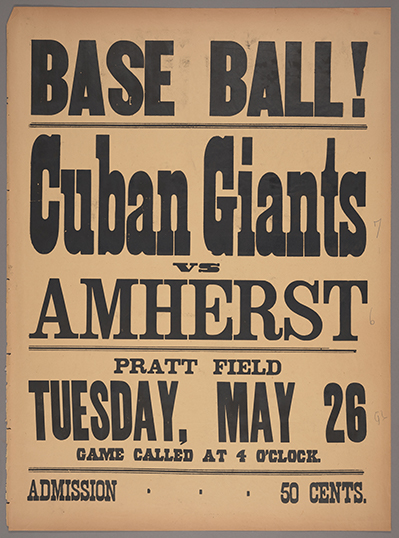Flipping through The New York Times Magazine this March, I was struck by one headline: “Justice for the Negro Leagues Will Mean More Than Just Stats.”
Ever since Major League Baseball decided, in 2020, to incorporate records from all-Black leagues into its standings, a discussion has intensified around acknowledging and atoning for decades of baseball segregation. The MLB had no Black players until 1947, when Jackie Robinson joined the Brooklyn Dodgers.
If you are a baseball fan, the new stats, once made official, will radically refresh your sports trivia knowledge. Which pitcher, for instance, threw a no-hitter on opening day? The MLB answer won’t just be Bob Feller, but now also Leon Day. Who hit over .400 for a season? Not just Ted Williams, but Josh Gibson.
Yet what does this have to do with Amherst?
You’d guess nothing, but I spied a tantalizing clue in the Times story: Author Rowan Ricardo Phillips mentioned seeing memorabilia from games between the Cuban Giants—the first Black professional baseball club—and Wesleyan’s baseball team in the 1890s.
It hit me: Did the Cuban Giants challenge the other two of the Little Three?
Yes! The Amherst archives has proof. College archivist Christina Barber tracked down a poster advertising a game at Pratt Field on May 27, 1896, and an Amherst Student dispatch on the match.
The College lost, 7-6, in a 10-inning game. You can gloat at Amherst’s respectable showing: the next day, the Cuban Giants trounced Williams, 16-8.
But those game stats won’t funnel into MLB standings. Only play from 1920 to 1948 is being considered. The MLB holds that earlier games don’t count, labeling them as lower-quality, a run of loosely recorded exhibition games and barnstorming tours.
Negro League players and achievements matter on their own, not just because the MLB recognizes them, of course. And deciding what constitutes “low-quality” play is a debatable, even troubling, pretext for excluding the early days of all-Black teams.
While the MLB is dismissing stats before 1920, the National Baseball Hall of Fame has inducted several Black players from earlier years. Incredibly, two of them played at Pratt Field that day in 1896: Frank Grant and Solomon White. Negro League scholar Jerry Malloy named Grant the best player of the 19th century.
A word about the Cuban Giants: No player was Cuban. The team was based in Trenton, N.J., and the moniker is part of a pattern of concealing African American origins from white spectators.
The Amherst game is part of the history of segregation but also, in one way, of integration. The College’s lone Black player, James Francis Gregory ’98, was the first Black student to captain an Eastern college baseball team. He was the son of a Howard University professor, and his family tree includes both Charles Drew ’26, who pioneered methods for storing blood plasma, and U.S. Supreme Court Justice Roger Taney, who delivered the majority opinion in the 1857 Dred Scott decision.
Here’s the story of this game and these players.



